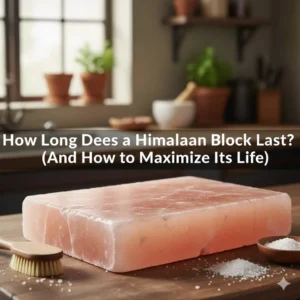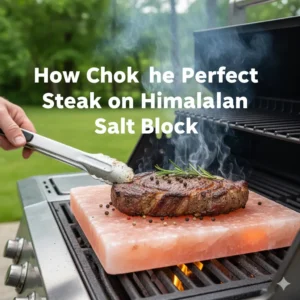Himalayan salt blocks serve as natural cooking surfaces that combine heat retention with subtle mineral seasoning. They allow chefs to sear, grill, or chill foods while imparting a delicate salinity and eye-catching presentation. For culinary professionals and home cooks alike, these blocks offer a clean, efficient way to enhance flavor without additives. This article explores how salt block cooking compares in vegan versus traditional applications—helping you determine which style best suits your kitchen and menu goals.
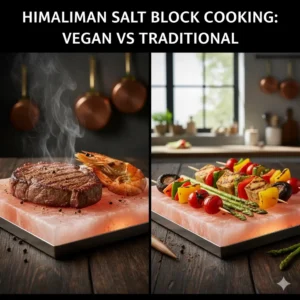
Vegan vs. Traditional Salt Block Cooking: Key Differences at a Glance
Choosing between vegan and traditional salt block cooking comes down to your preferred flavors, dietary approach, and cooking objectives. The comparison below highlights how plant-based dishes differ from meat-focused preparations in ingredients, taste, timing, and purpose.
| Feature | Vegan Salt Block Recipes | Traditional Salt Block Cooking |
|---|---|---|
| Primary Ingredients | Vegetables, tofu, fruits, and other plant-based proteins that highlight clean, natural flavors. | Meats, seafood, and poultry that develop rich flavor from caramelized fat and juices. |
| Flavor Profile | Subtle umami and gentle salinity enhanced through caramelization of vegetables and tofu. | Bold smoky depth with pronounced saltiness intensified by rendered fat and natural juices. |
| Cooking Time | Typically short to medium, averaging three to twelve minutes for most plant-based items. | Often longer and more variable, particularly for dense cuts of meat or seafood. |
| Health Considerations | Nutrient-dense and naturally low in fat, suitable for vegan and vegetarian diets. | Protein-rich but generally higher in saturated fat and cholesterol. |
| Typical Usage Scenarios | Ideal for plant-forward meals, vegan entertaining, and health-conscious cooking. | Common in barbecues, grilling sessions, and traditional meat-based menus. |
What Is Vegan Himalayan Salt Block Cooking?
Vegan Himalayan salt block cooking involves grilling or searing vegetables, tofu, and fruits directly on a heated block of pink Himalayan salt. Acting as both a cooking surface and a natural seasoning, the block imparts gentle salinity and umami depth that enhances the food’s inherent flavor.
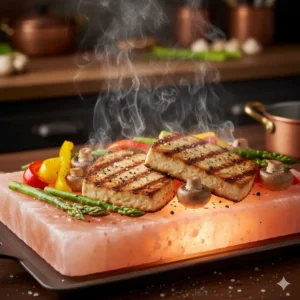
Heated to around four hundred degrees Fahrenheit, the block sears ingredients quickly, forming a delicate crust that seals in moisture without relying on oil or heavy seasoning. This approach delivers the texture and complexity of traditional searing methods while keeping dishes clean and plant-forward.
Popular examples include tofu steaks with soy-ginger marinades, grilled portobello mushrooms, asparagus, zucchini, avocado halves, and caramelized fruits. Each cooks evenly under consistent heat, developing a tender interior and lightly salted exterior—ideal for balanced, flavor-focused plant-based meals.
What Is Traditional Himalayan Salt Block Cooking?
Traditional Himalayan salt block cooking focuses on high-heat searing and grilling of proteins such as steak, fish, poultry, and shellfish. The dense mineral surface reaches extreme heat, allowing chefs to create a crisp, savory crust that seals in moisture while naturally seasoning the food.
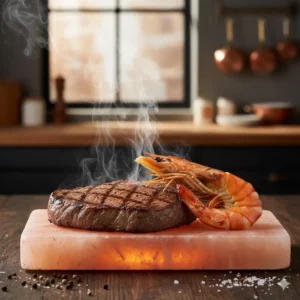
The salt block intensifies umami and enhances natural juices, producing a balanced combination of salinity and sweetness that defines premium restaurant-style dishes. Skilled cooks appreciate this technique for transforming simple ingredients into flavorful, sophisticated meals without heavy marinades or added seasoning.
Effective temperature control is essential. The block must be heated gradually to prevent cracking and achieve consistent surface heat for precise searing. Once it reaches cooking temperature, its even heat distribution produces clean grill marks and uniform doneness across every piece of meat or seafood.
Head-to-Head Comparison: Vegan vs. Traditional Salt Block Cooking
Flavor and Texture
When cooking vegan dishes on a Himalayan salt block, the heat draws out natural sugars in vegetables and plant proteins, creating gentle caramelization and a subtle salt infusion. This enhances umami depth without overwhelming the clean, fresh flavors of the ingredients. Grilled tofu, eggplant, or asparagus develop a satisfying sear that delivers both texture and balance.
Traditional salt block cooking, by contrast, results in a more assertive crust. As meat juices interact with the salt, they build a rich, savory layer with pronounced smokiness. While vegan recipes emphasize delicacy and freshness, traditional methods lean toward intensity and fullness—each delivering a distinct expression of flavor chemistry between heat, salt, and moisture.
Cooking Techniques and Timing
Plant-based recipes typically cook faster on a salt block. Most vegetables need only a few minutes per side for ideal tenderness, while tofu sears in about five to seven minutes. The goal is even caramelization without losing moisture. Because these ingredients release little fat, a light brushing of oil prevents sticking and ensures clean presentation.
Traditional salt block meals often require longer cooking times and precise temperature control for even doneness. Excess heat can char meat juices, so maintaining a steady temperature is essential. Both styles follow the same principle—heat the block gradually to avoid cracking—but vegan recipes offer greater flexibility, tolerating minor temperature variations without affecting quality.
Health and Dietary Benefits
Vegan salt block cooking naturally aligns with plant-forward diets. It minimizes added fats and keeps nutrients intact while letting the salt’s gentle seasoning enhance flavor. Emphasizing vegetables, fruits, and tofu supports higher fiber intake, antioxidant value, and overall nutritional balance.
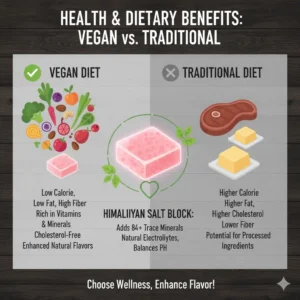
Traditional salt block dishes provide robust protein content but can also introduce more saturated fats, requiring balanced portion sizes. Across both methods, the block contributes minimal sodium since seasoning forms only on the food’s surface. For professionals or consumers seeking cleaner, nutrient-rich options, vegan salt block cooking delivers both health benefits and culinary sophistication.
Premium Himalayan Salt Blocks for Culinary & Retail
Partner with Jilin Ever Creation for authentic, food-grade pink Himalayan salt blocks sourced from the Khewra Salt Mine. These mineral-rich blocks are ideal for vegan, vegetarian, and plant-based recipes—enhancing the flavor of tofu, vegetables, and fruits through natural salinity and consistent heat retention. Choose customized sizes, shapes, and packaging, supported by global shipping solutions designed for chefs, retailers, and hospitality professionals.
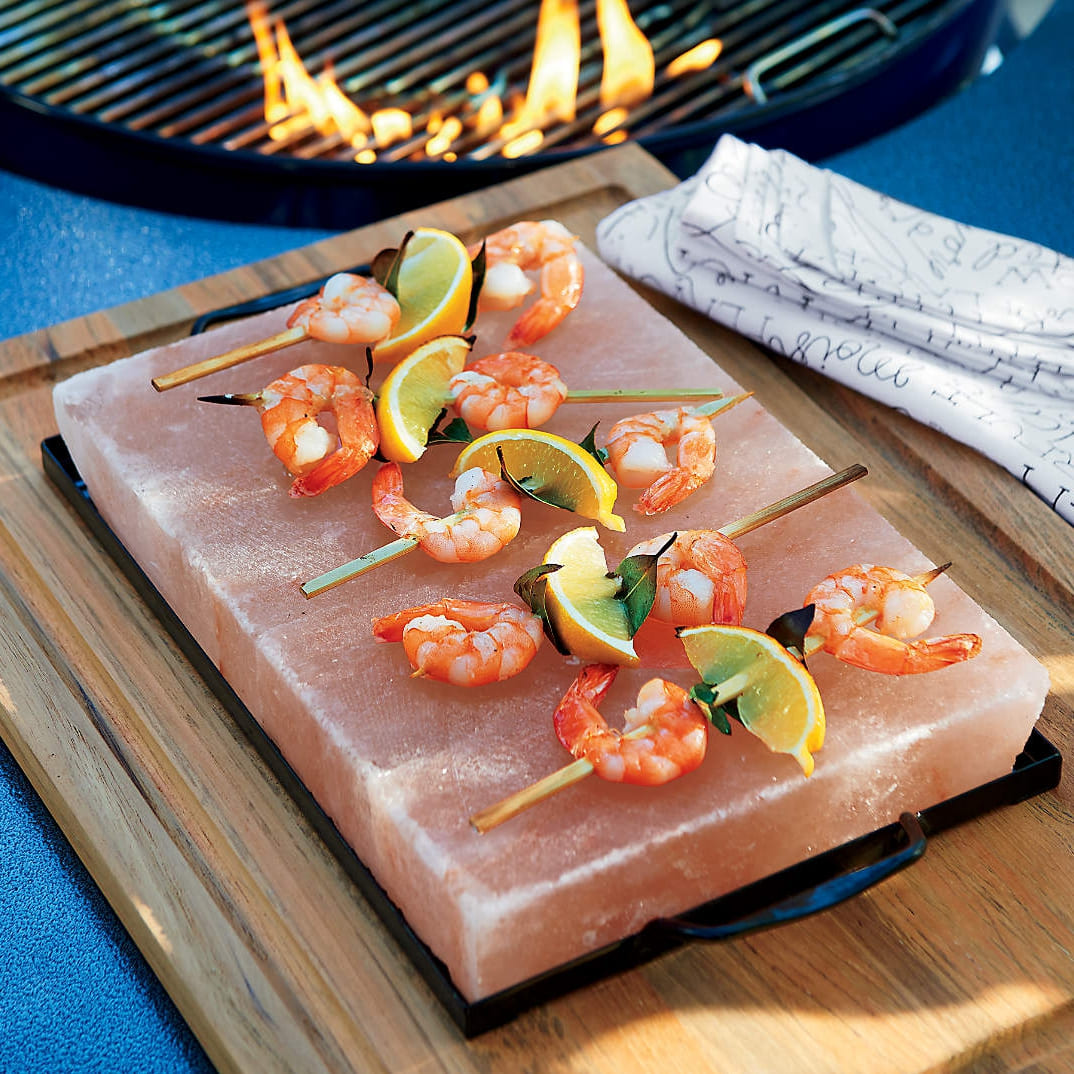
Top Vegan Recipes for Himalayan Salt Block Cooking
Cooking plant-based dishes on a Himalayan salt block unlocks flavors that conventional cookware can’t reproduce. The block’s steady heat imparts gentle salinity while intensifying the natural umami and sweetness of vegetables and tofu. This technique brings dimensional taste and texture to vegan cooking—enhancing each ingredient without excess salt, oil, or sauces.
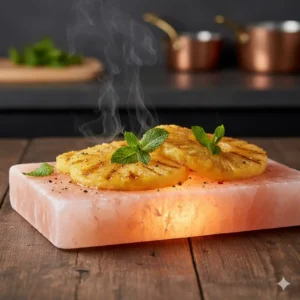
Explore these simple yet flavorful vegan applications:
- Salt Block Tofu Steaks: Pressed tofu marinated with soy sauce, garlic, and ginger develops a golden crust and deep, savory character.
- Grilled Portobello Mushrooms: A balsamic and herb coating accentuates the hearty texture, ideal for a plant-based burger alternative or main entrée.
- Roasted Asparagus Spears: Lightly brushed with olive oil and black pepper, asparagus gains a tender bite and subtle smokiness from the block’s radiant heat.
- Caramelized Pineapple Slices: Glazed with maple syrup, these slices achieve a balanced sweet–salty caramelization perfect for a light vegan dessert.
Each recipe demonstrates how straightforward, whole-food ingredients gain complexity through salt block cooking—a method that emphasizes creativity, clean flavor, and natural balance in every plant-based meal.
Care and Maintenance of Your Himalayan Salt Block
Proper care ensures your Himalayan salt block remains durable and performs consistently over time. Because salt reacts to sudden temperature changes, always bring the block up to cooking heat gradually. Begin on low heat for about twenty minutes, increase to medium for another twenty, and finish on high. This slow heating process minimizes internal stress, prevents cracking, and guarantees even searing for vegan and plant-based dishes.

After cooking, let the block cool completely before cleaning. When it is safe to handle, gently wipe away any residue with a damp sponge. Avoid soap or detergents—these can erode the surface and leave residual flavors that affect the taste of vegetables, tofu, or fruit.
Keep moisture exposure to a minimum. Never soak or rinse the block under running water, as excessive liquid dissolves the salt and shortens its lifespan. Once cleaned, allow it to dry fully in a cool, ventilated area before storing. With consistent maintenance, your salt block will remain a reliable, flavor-enhancing surface for countless vegan creations.
Frequently Asked Questions About Himalayan Salt Block Cooking
How can I prevent tofu from sticking to the salt block?
Press the tofu to remove excess moisture, then brush it with a thin layer of oil before placing it on the hot surface. When the salt block is properly heated—around 400°F—it naturally forms a sear that allows smooth flipping without tearing. Using a flat spatula instead of tongs further reduces the risk of sticking.
What’s the best way to cook vegetables on a salt block?
Preheat the block gradually through low, medium, and high stages to prevent cracking. Lightly coat vegetables with olive oil and arrange them evenly across the surface for uniform searing. The salt draws out moisture and adds gentle seasoning, giving vegetables such as asparagus and zucchini a subtly smoky depth.
Will the block retain flavors from strong vegetables like onions?
Himalayan salt blocks are dense and nonporous, so they don’t absorb flavors deeply. After cooking aromatic ingredients, allow the block to cool completely and wipe it clean with a damp sponge. Once dry, it’s ready to use again for fruits, tofu, or desserts without any transfer of taste.
Should I use oil when cooking vegan food on a salt block?
Yes—but sparingly. A light brush of oil minimizes sticking and promotes caramelization, especially for vegetables and tofu. Using too much oil can discolor the surface or create smoke, so a minimal amount is all that’s needed for effective searing.
Can I make vegan desserts on a Himalayan salt block?
Definitely. Fruits such as pineapple, peaches, and plums caramelize beautifully on a warm salt block, creating a balanced sweet-salty flavor. For added richness, finish them with a drizzle of maple syrup or balsamic glaze for a simple, plant-based dessert.
Final Thoughts
Vegan Himalayan salt block cooking transforms simple ingredients like vegetables and tofu into refined, flavor-rich meals. The block’s consistent heat and natural salinity create an umami-forward crust that enhances texture and depth while maintaining nutritional integrity.
Choose vegan salt block recipes if you favor fresh, nutrient-dense cooking with balanced flavors and minimal seasoning. Traditional salt block grilling remains ideal for those seeking the bold, smoky richness of meat and seafood dishes.
For authentic, food-grade Himalayan salt blocks, partner with Jilin Ever Creation to bring professional-grade flavor, precision, and natural balance to every plant-based creation.




